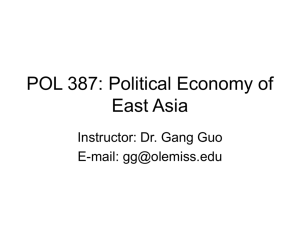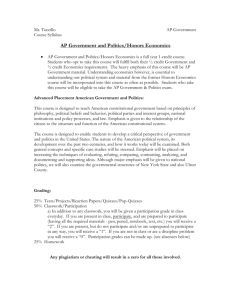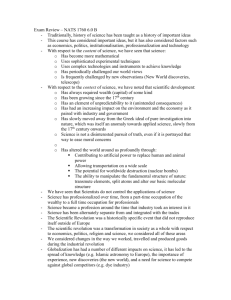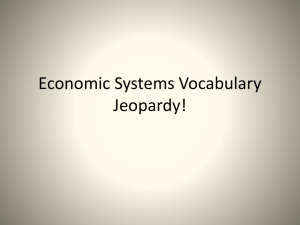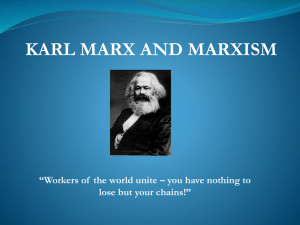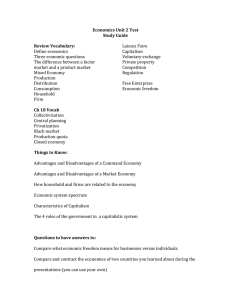Structuralism I. Basic Principles of Marxism II. Three Questions
advertisement
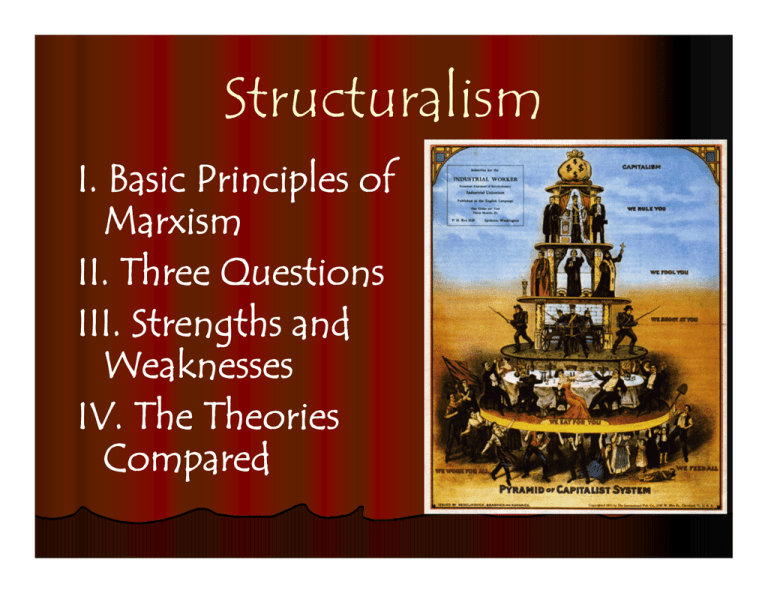
Structuralism I. Basic Principles of Marxism II. Three Questions III. Strengths and Weaknesses IV. The Theories Compared Key Marxist Thinkers Karl Marx (1818-83) V.I. Lenin (1870-1924) Basic Marxist Principles Dialectical Approach Materialism Thesis ↔ antithesis synthesis Economic development is dynamic and conflictual Structure and Superstructure Economics primary over Politics Historicism Primitive communism Ancient Empires Feudalism Capitalism Socialism Communism Historical contradictions of Capitalism Lenin and Imperialism Normative Commitment to Marxism Egalitarianism over efficiency Marxist View of Society Ideas, Values, Beliefs, Laws (Ideological ‘Superstructure’) Social Relations (Modes) of Production (Base or ‘Structure’) Forces of Production (Material Resources and Technology) Structuralism: Three Questions What is the economy for? How does the economy work? Normative: To help the masses Empirical: To serve the wealthy by exploiting the masses Dependency Theory (Terms of Trade and dependent development) World System Theory (Core, Periphery and Semiperiphery) Antonio Gramsci and “Intellectual Hegemony” Relationship between Politics and Economics? Political organization derives from economic organization Structuralism: Strengths Highlights Nature of Inequality in IPE Relates National Development to International Economy Marx and the Current Crisis Occupy Wall Street movement Structuralism: Weaknesses Failure of Communism Poorly Developed Concepts Influence of International versus Domestic in National Economic Development Chiapas rebels in Mexico The Theories Compared THEORY Liberalism Mercantilism Structuralism BASIC UNIT OF ANALYSIS Private Actors (Individuals and Firms) State (National Economy as Economic Tool of State Power) Class (Domination of classes within Capitalism) PURPOSE OF THE NATIONAL ECONOMY Promote individual welfare (by maximizing efficiency and growth) Promote state power (via national economic development [producer interests]) Promote class interests (domestic or core vs. periphery) UNDERLYING LOGIC OF ECONOMIC INTERACTION NATURE OF ECONOMIC INTERACTION RELATIONSHIP BETWEEN POLITICS AND ECONOMICS POLICY GUIDANCE Markets driven by prices (Laws of Supply and Demand) Harmonious between individuals/ States (absolute gains; everyone wins) Separate (Economics should be kept separate from politics) DOMESTIC: free market and minimal govt. interference INTERNATIONAL: free trade and capital flows Markets driven by (state) market power Conflictual across states (relative gains; some win more than others) United (Economics alters state power; economics subordinate to politics) DOMESTIC: Industrial policies [sectoral intervention] INTERNATIONAL: strategic trade [limited protection] Markets driven by class interests, both domestic and international (uneven development) Conflictual across classes and states (system serves interests of dominant group) Politics derives from economics (politics subordinate to economics; structure and superstructure) DOMESTIC: protectionism and ‘import substitution’ INTERNATIONAL: reform of IPE/closed economies
